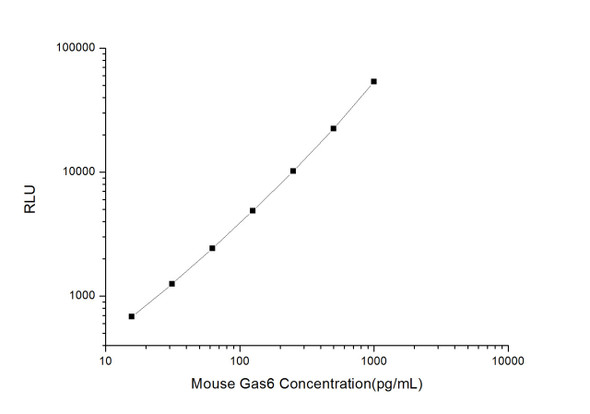Human Developmental Biology ELISA Kits
Human Gas6 (Growth Arrest Specific Protein 6) CLIA Kit (HUES00076)
- SKU:
- HUES00076
- Product Type:
- ELISA Kit
- ELISA Type:
- CLIA Kit
- Size:
- 96 Assays
- Sensitivity:
- 9.38pg/mL
- Range:
- 15.63-1000pg/mL
- ELISA Type:
- Sandwich
- Synonyms:
- GAS-6, AXLLG, AXSF
- Reactivity:
- Human
- Sample Type:
- Serum, plasma and other biological fluids
- Research Area:
- Developmental Biology
Description
| Assay type: | Sandwich |
| Format: | 96T |
| Assay time: | 4.5h |
| Reactivity: | Human |
| Detection method: | Chemiluminescence |
| Detection range: | 15.63-1000 pg/mL |
| Sensitivity: | 9.38 pg/mL |
| Sample volume: | 100µL |
| Sample type: | Serum, plasma and other biological fluids |
| Repeatability: | CV < 15% |
| Specificity: | This kit recognizes Human Gas6 in samples. No significant cross-reactivity or interference between Human Gas6 and analogues was observed. |
This kit uses Sandwich-CLIA as the method. The micro CLIA plate provided in this kit has been pre-coated with an antibody specific to Human Gas6. Standards or samples are added to the appropriate micro CLIA plate wells and combined with the specific antibody. Then a biotinylated detection antibody specific for Human Gas6 and Avidin-Horseradish Peroxidase (HRP) conjugate are added to each micro plate well successively and incubated. Free components are washed away. The substrate solution is added to each well. Only those wells that contain Human Gas6, biotinylated detection antibody and Avidin-HRP conjugate will appear fluorescence. The Relative light unit (RLU) value is measured spectrophotometrically by the Chemiluminescence immunoassay analyzer. The RLU value is positively associated with the concentration of Human Gas6. The concentration of Human Gas6 in the samples can be calculated by comparing the RLU of the samples to the standard curve.
| UniProt Protein Function: | GAS6: Ligand for tyrosine-protein kinase receptors AXL, TYRO3 and MER whose signaling is implicated in cell growth and survival, cell adhesion and cell migration. GAS6/AXL signaling plays a role in various processes such as endothelial cell survival during acidification by preventing apoptosis, optimal cytokine signaling during human natural killer cell development, hepatic regeneration, gonadotropin-releasing hormone neuron survival and migration, platelet activation, or regulation of thrombotic responses. 4 isoforms of the human protein are produced by alternative splicing. |
| UniProt Protein Details: | Protein type:Ligand, receptor tyrosine kinase; Secreted; Secreted, signal peptide Chromosomal Location of Human Ortholog: 13q34 Cellular Component: cytoplasm; endoplasmic reticulum lumen; extracellular region; extracellular space; Golgi lumen Molecular Function:calcium ion binding; caspase inhibitor activity; molecular adaptor activity; phosphatidylserine binding; protein binding; protein tyrosine kinase activator activity; receptor agonist activity; receptor binding; receptor tyrosine kinase binding; voltage-gated calcium channel activity Biological Process: activation of protein kinase B; apoptotic cell clearance; blood coagulation; cell adhesion; cell cycle arrest; cell migration; cell proliferation; cell-substrate adhesion; cellular protein metabolic process; cellular response to starvation; entry of virus into host cell; enzyme linked receptor protein signaling pathway; ER to Golgi vesicle-mediated transport; leukocyte migration; negative regulation of apoptosis; negative regulation of caspase activity; negative regulation of interferon-gamma production; negative regulation of interleukin-1 secretion; negative regulation of interleukin-6 production; negative regulation of protein import into nucleus, translocation; negative regulation of transcription factor activity; negative regulation of transcription, DNA-dependent; negative regulation of tumor necrosis factor production; neuron migration; organ regeneration; peptidyl-glutamic acid carboxylation; peptidyl-serine phosphorylation; phagocytosis; platelet activation; platelet degranulation; positive regulation of cytokine and chemokine mediated signaling pathway; positive regulation of fibroblast proliferation; positive regulation of glomerular filtration; positive regulation of natural killer cell differentiation; positive regulation of peptidyl-serine phosphorylation; positive regulation of phagocytosis; positive regulation of protein amino acid phosphorylation; positive regulation of protein export from nucleus; positive regulation of protein kinase activity; positive regulation of protein kinase B signaling cascade; positive regulation of TOR signaling pathway; post-translational protein modification; protein amino acid phosphorylation; protein kinase B signaling cascade; regulation of growth; signal peptide processing; signal transduction; viral envelope fusion with host membrane; viral genome replication; virion attachment, binding of host cell surface receptor |
| NCBI Summary: | This gene encodes a gamma-carboxyglutamic acid (Gla)-containing protein thought to be involved in the stimulation of cell proliferation. This gene is frequently overexpressed in many cancers and has been implicated as an adverse prognostic marker. Elevated protein levels are additionally associated with a variety of disease states, including venous thromboembolic disease, systemic lupus erythematosus, chronic renal failure, and preeclampsia. [provided by RefSeq, Aug 2014] |
| UniProt Code: | Q14393 |
| NCBI GenInfo Identifier: | 48427995 |
| NCBI Gene ID: | 2621 |
| NCBI Accession: | Q14393. 2 |
| UniProt Secondary Accession: | Q14393,Q6IMN1, Q7Z7N3, B3KRQ7, B3KVL4, E9PBL7, |
| UniProt Related Accession: | Q14393 |
| Molecular Weight: | 41,986 Da |
| NCBI Full Name: | Growth arrest-specific protein 6 |
| NCBI Synonym Full Names: | growth arrest specific 6 |
| NCBI Official Symbol: | GAS6 |
| NCBI Official Synonym Symbols: | AXSF; AXLLG |
| NCBI Protein Information: | growth arrest-specific protein 6 |
| UniProt Protein Name: | Growth arrest-specific protein 6 |
| UniProt Synonym Protein Names: | AXL receptor tyrosine kinase ligand |
| Protein Family: | Growth arrest-specific protein |
| UniProt Gene Name: | GAS6 |
| UniProt Entry Name: | GAS6_HUMAN |
As the RLU values of the standard curve may vary according to the conditions of the actual assay performance (e. g. operator, pipetting technique, washing technique or temperature effects), the operator should establish a standard curve for each test. Typical standard curve and data is provided below for reference only.
| Concentration (pg/mL) | RLU | Average | Corrected |
| 1000 | 49960 57390 | 53675 | 53650 |
| 500 | 20381 24597 | 22489 | 22464 |
| 250 | 10438 9984 | 10211 | 10186 |
| 125 | 4788 5014 | 4901 | 4876 |
| 62.5 | 2625 2281 | 2453 | 2428 |
| 31.25 | 1315 1247 | 1281 | 1256 |
| 15.63 | 704 712 | 708 | 683 |
| 0 | 24 26 | 25 | -- |
Precision
Intra-assay Precision (Precision within an assay): 3 samples with low, mid range and high level Human Gas6 were tested 20 times on one plate, respectively.
Inter-assay Precision (Precision between assays): 3 samples with low, mid range and high level Human Gas6 were tested on 3 different plates, 20 replicates in each plate.
| Intra-assay Precision | Inter-assay Precision | |||||
| Sample | 1 | 2 | 3 | 1 | 2 | 3 |
| n | 20 | 20 | 20 | 20 | 20 | 20 |
| Mean (pg/mL) | 49.55 | 146.58 | 470.59 | 49.90 | 151.85 | 447.06 |
| Standard deviation | 6.44 | 12.86 | 48.09 | 6.18 | 17.42 | 37.55 |
| C V (%) | 13.00 | 8.77 | 10.22 | 12.38 | 11.47 | 8.40 |
Recovery
The recovery of Human Gas6 spiked at three different levels in samples throughout the range of the assay was evaluated in various matrices.
| Sample Type | Range (%) | Average Recovery (%) |
| Serum (n=5) | 90-104 | 98 |
| EDTA plasma (n=5) | 95-112 | 102 |
| Cell culture media (n=5) | 92-108 | 99 |
Linearity
Samples were spiked with high concentrations of Human Gas6 and diluted with Reference Standard & Sample Diluent to produce samples with values within the range of the assay.
| Serum (n=5) | EDTA plasma (n=5) | Cell culture media (n=5) | ||
| 1:2 | Range (%) | 92-109 | 87-100 | 91-103 |
| Average (%) | 100 | 92 | 97 | |
| 1:4 | Range (%) | 103-117 | 98-113 | 93-106 |
| Average (%) | 109 | 104 | 98 | |
| 1:8 | Range (%) | 95-109 | 96-110 | 100-115 |
| Average (%) | 102 | 101 | 105 | |
| 1:16 | Range (%) | 90-105 | 96-108 | 95-108 |
| Average (%) | 97 | 102 | 100 |
An unopened kit can be stored at 4°C for 1 month. If the kit is not used within 1 month, store the items separately according to the following conditions once the kit is received.
| Item | Specifications | Storage |
| Micro CLIA Plate(Dismountable) | 8 wells ×12 strips | -20°C, 6 months |
| Reference Standard | 2 vials | |
| Concentrated Biotinylated Detection Ab (100×) | 1 vial, 120 µL | |
| Concentrated HRP Conjugate (100×) | 1 vial, 120 µL | -20°C(shading light), 6 months |
| Reference Standard & Sample Diluent | 1 vial, 20 mL | 4°C, 6 months |
| Biotinylated Detection Ab Diluent | 1 vial, 14 mL | |
| HRP Conjugate Diluent | 1 vial, 14 mL | |
| Concentrated Wash Buffer (25×) | 1 vial, 30 mL | |
| Substrate Reagent A | 1 vial, 5 mL | 4°C (shading light) |
| Substrate Reagent B | 1 vial, 5 mL | 4°C (shading light) |
| Plate Sealer | 5 pieces | |
| Product Description | 1 copy | |
| Certificate of Analysis | 1 copy |
- Set standard, test sample and control (zero) wells on the pre-coated plate and record theirpositions. It is recommended to measure each standard and sample in duplicate. Note: addall solutions to the bottom of the plate wells while avoiding contact with the well walls. Ensuresolutions do not foam when adding to the wells.
- Aliquot 100µl of standard solutions into the standard wells.
- Add 100µl of Sample / Standard dilution buffer into the control (zero) well.
- Add 100µl of properly diluted sample (serum, plasma, tissue homogenates and otherbiological fluids. ) into test sample wells.
- Cover the plate with the sealer provided in the kit and incubate for 90 min at 37°C.
- Aspirate the liquid from each well, do not wash. Immediately add 100µL of BiotinylatedDetection Ab working solution to each well. Cover the plate with a plate seal and gently mix. Incubate for 1 hour at 37°C.
- Aspirate or decant the solution from the plate and add 350µL of wash buffer to each welland incubate for 1-2 minutes at room temperature. Aspirate the solution from each well andclap the plate on absorbent filter paper to dry. Repeat this process 3 times. Note: a microplatewasher can be used in this step and other wash steps.
- Add 100µL of HRP Conjugate working solution to each well. Cover with a plate seal andincubate for 30 min at 37°C.
- Aspirate or decant the solution from each well. Repeat the wash process for five times asconducted in step 7.
- Add 100µL of Substrate mixture solution to each well. Cover with a new plate seal andincubate for no more than 5 min at 37°C. Protect the plate from light.
- Determine the RLU value of each well immediately.






